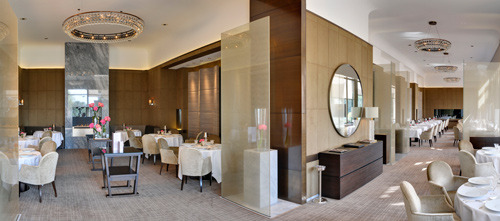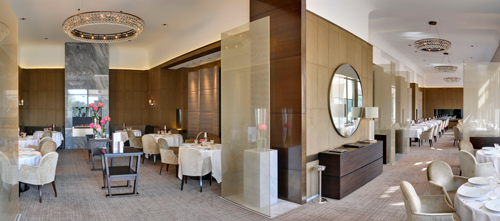Eating In The Capital Of The Olympics
The 2012 Olympic Games begin in London on July 27. But unless you planned way ahead or have some mighty good connections, you're probably not going. If you want to get a little taste of the Olympics, though, and eat some good food while you're at it, there's an alternative destination you might consider: Lausanne, Switzerland, official headquarters of the International Olympic Committee.
Overlooking Lake Geneva (or Lac Léman, as the Swiss prefer to call it), about 35 miles from Geneva itself, Lausanne is a quiet, attractive city on a piece of gently curving shoreline at the top of the lake. It's up high enough to be able to survey much of the surrounding landscape, with its dramatic Alpine backdrop, but borders the lake and thus is linked intimately with its cosmopolitan community of commerce and leisure. (For one thing, the famous spa of Evian, with its black-tie-and-ball gown casino, is sparklingly visible just across the water on the French side of the lake.)
The earliest settlement on this spot dates from Roman times, if not earlier, but Lausanne — named for the river, once called the Laus, now the Flon, which flows into it from the north — began to grow into a real city only in the 15th century. Between 1536 and 1798 it was occupied by the Bernese, and was a municipality of only minor importance in the Swiss Confederation, but in 1803, when Napoleon divided Switzerland into 19 new cantons, the city was named capital of the canton of Vaud, and its fortunes improved. Later in the 19th century, it grew into an important railway junction, and with the opening of the Simplon Tunnel on the route to Italy in 1906, it found itself in the middle of the principal trade corridor between Paris and Milan, and profited accordingly.
The city owes its Olympic connection to Pierre de Frédy, the Baron de Coubertin, the visionary French educator who founded the modern Olympic Games in the late 19th century. The Baron was quite taken with Lausanne, attracted by its beauty and its central location (at least in Western European terms), and probably also by the fact of Switzerland's traditional political neutrality, and he decided that it would be the perfect home for his new organization. Accordingly, he negotiated contracts with the city, signed in 1915 at the Lausanne Town Hall, which provided for facilities for committee offices and archives here, and for an Olympics museum.
The IOC's first home in Lausanne was in a suite of rooms at the Casino de Montbenon in the middle of town (still used for civic functions). Soon outgrowing the space, the organization moved first to the Villa Mon-Repos (a 17th-century chateau in which Voltaire had staged his famous tragedy Zaire for friends in the 1730s) in the beautiful city park of the same name, and later to the Chateau de Vidy in the suburb of Vidy, just southwest of the city, where it remains to this day.
There isn't much to see there. There has been an Olympics museum on the site since de Courbetin's day. It closed down in 1970, reopening a dozen years later in a rather haphazard, even slightly tacky incarnation. (A poster for the ill-fated 1972 Munich games included just this one reference to the massacre there of Israeli athletes: "The Olympic Games certainly were in no way responsible for the carnage. They were used by the Palestinians as a 'sounding board', to quote a term used by Jean Lacourtre in Le Monde.") That museum was replaced by another, considerably more elaborate, in 1993, on the 99th anniversary of de Courbertin's initial call for a revived Olympic Games. That one, in turn, closed down last year, with a newer, more improved version scheduled to debut in 2014.
In the meantime, though, Lausanne has other attractions, among them the 13th-century cathedral of Notre Dame, which boasts a remarkable rose window, several beautiful polychrome wood figures, and at least the ghosts of some impressive frescoes; the Fondation AsherEdelman Musée d'Art Contemporain, founded by and named for the famed NewYork corporate raider of the 1980s, which mounted the first European retrospectives of Robert Mapplethorpe, Jean-Michel Basquiat, and Roy Lichtenstein, among others; and the Collection de l'Art Brut, a fascinating museum of outsider art.
Oh, and the food? One of the great gastronomic shrines of Europe is a few miles from Lausanne, in the town of Crissier. This is the restaurant known for decades as Girardet, after the legendary chef Fredy Girardet, considered by all the great French chefs to be "le Pape", the Pope, of haute cuisine. In 1996, Girardet sold the place to his longtime sous chef, Philippe Rochat (he later regretted his premature retirement), and Rochat renamed it after himself and proved to be every bit as superb a chef as his predecessor had been. On March 31, Rochat cooked his last meal there and himself retired, handing over the ovens to his own longtime sous chef Benoît Violier. The cuisine remains in the style that might be called contemporary classic, with dishes like scallops in acidulated carrot juice with lime and ginger, Bresse chicken wings in curry sauce, poached Charolais beef filet with black truffles, and terrine of rabbit with spring vegetables. Service is impeccable here, the wine list is a masterpiece (definitely try something from the large selection of Swiss vintages, some of them remarkable), and the cheese tray is extraordinary.
There's spectacular cuisine in Lausanne itself, too, though, from the Swiss kitchen of French three-star chef Anne-Sophie Pic, whose first restaurant is the celebrated Pic in Valence, across the border in France. Pic's Lausanne preserve is the small, beautifully furnished dining room (above) of the Beau-Rivage Palace in the neighborhood of Ouchy — one of the great grand hotels of Western Europe. Here, Pic serves imaginative multicultural French cooking of the highest order. Recent specialties have included such dishes as miniature green peas with cream of spring onions and caviar; fera, a delicious whitefish caught in Lake Geneva, grilled and served with a coffee-scented turnip mousse; pan-roasted Simmenthal veal loin with a licorice-flavored compote of artichokes and sweet onions; and rhubarb sorbet and jam with homemade vanilla and ginger yogurt. (Photo courtesy of Beau Rivage)
The same hotel also hosts Miyako, an elegant Japanese restaurant taking good advantage of the wealth of fish and shellfish available here, and the more casual La Terasse, which serves modernized versions of traditional French and Swiss specialties, and is a great place to taste more lake fish, including perch and the char-like omble chevalier.
For an enjoyable Swiss bistro experience, there's also Café Romand, in the middle of town, where the offerings might include green lentils with smoked bacon and local sausage; veal in cream sauce with rösti (the addictive Swiss version of hash browns); steamed cod with rice pilaf; and tartiflette — a serious winter dish of potatoes, bacon lardons, and onions, luxuriating in a cloak of heavy cream and lots of melted reblochon cheese. It's not exactly summer fare, but it would definitely take your mind off London.

